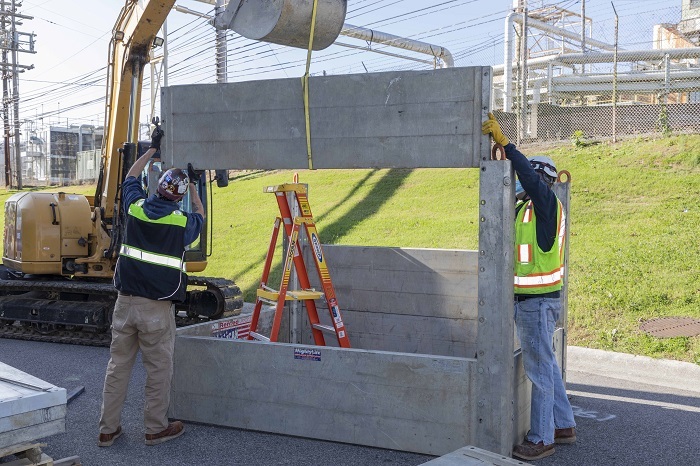 Workers dismantle transport platforms at the Y-12 National Security Complex so they can be taken to the Oak Ridge National Laboratory. The platforms will be installed to support deactivation activities at the eight-story Experimental Gas-Cooled Reactor.
OAK RIDGE, Tenn. – Reuse of transport platforms — large elevator-like devices installed outside facilities that allow workers to access multiple floors — among EM cleanup projects in Oak Ridge will save nearly $3.5 million.
“Our cleanup program is focused on completing projects successfully while also being extremely mindful of any efficiencies we can achieve to be responsible stewards of tax dollars,” Oak Ridge Office of Environmental Management (OREM) Manager Jay Mullis said. “We recently completed core cleanup at the East Tennessee Technology Park $80 million under budget, and that is a trend we look to continue as we move forward with cleanup at the Y-12 National Security Complex and Oak Ridge National Laboratory (ORNL).”
 A view of one of the transport platforms installed outside the six-story Building 9207 at the Y-12 National Security Complex’s Biology Complex. These platforms allowed crews to move abatement equipment and remove packaged asbestos and hazardous waste from the building’s higher floors and roof.
OREM and cleanup contractor UCOR had the platforms installed at Y-12’s Biology Complex to support deactivation activities to prepare remaining structures in the complex for demolition. The platforms allowed crews to accelerate that work and paved the way for a teardown that began last week.
With the transport platforms, crews were able to more easily move asbestos abatement equipment and restock supplies inside the Biology Complex’s three-story- and six-story-tall buildings. Workers also used the platforms to remove packaged asbestos and hazardous waste from higher floors and the roof.
As the start of demolition on the Biology Complex approached, OREM and UCOR worked collaboratively to identify additional uses for the equipment.
Only a few miles away, at ORNL, OREM and UCOR were starting to plan for another major deactivation project at the Experimental Gas-Cooled Rector. Standing eight stories tall, it presented a perfect opportunity to reuse the platforms.
Due to the size of the reactor, crews will again need additional capacity to reach the upper levels to support deactivation activities.
“Transferring the transport platforms from a cleanup project at Y-12 to one at ORNL became an obvious ‘win-win,’ eliminating the need to buy more costly equipment,” said Dan Macias, Oak Ridge Reservation environmental cleanup program manager for UCOR.
-Contributor: Susanne Dupes
 The sun begins to rise behind the 400-foot Hanford Meteorological Station tower, a source of current and historical weather data for the Hanford Site since 1944.
RICHLAND, Wash. – At the Hanford Site, weather data drives decisions that keep the workforce safe and healthy through high temperatures in the desert summer, powerful winds, and freezing rain and snow in the winter. The Hanford Meteorological Station is an invaluable resource for work planners and site leaders.
In operation since 1944 and currently managed by EM Richland Operations Office (RL) contractor Mission Support Alliance, the station receives data from 30 instrument towers on and around the 580-square-mile site. The most recognizable to workers is the 400-foot tower located near the center of the site, which collects meteorological data from sensors at several levels of the structure.
The meteorological team’s toolbox also includes remote sensors, giving them an edge in collecting accurate data across the site for the heat index, winter weather, thunderstorms, and wind speeds. Winds can gust above 40 miles per hour more than 20 days during the year.
“The weather station is a significant aid to our workforce, from keeping them safe in the summer heat or providing advance warnings to weather systems such as extreme wind conditions that could impair personal safety or force the temporary halt of work on the site to protect both the workers and the surrounding communities,” said Kyle Rankin, RL chief engineer. “Having access to this data and forecasters who understand weather patterns is a huge asset to the site.”
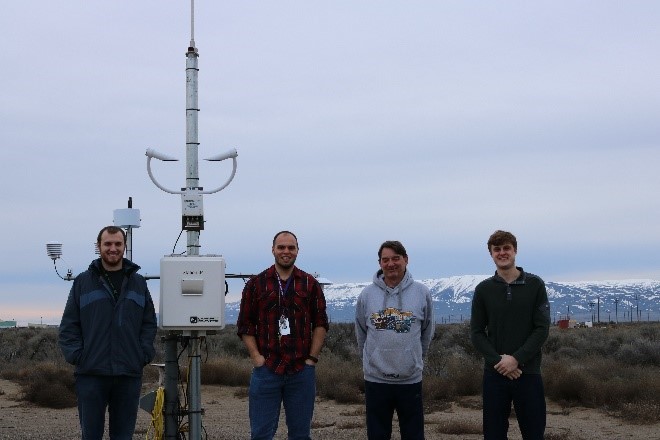 From left, meteorologists Matt Eckhoff, Grant Gutierrez, Perry Perrault, and Josh Markel with Mission Support Alliance help monitor weather conditions around the site 24 hours a day, seven days a week. This photo was taken prior to the COVID-19 pandemic.
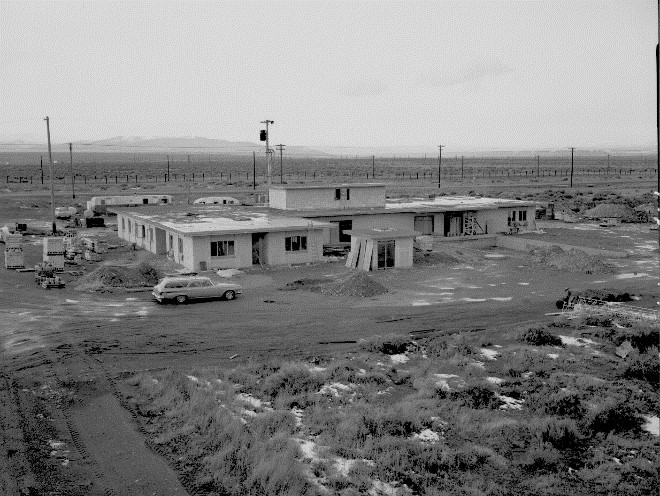 Constructed in the 1960s, the current Hanford Meteorological Station replaced the original small two-story station, shown above.
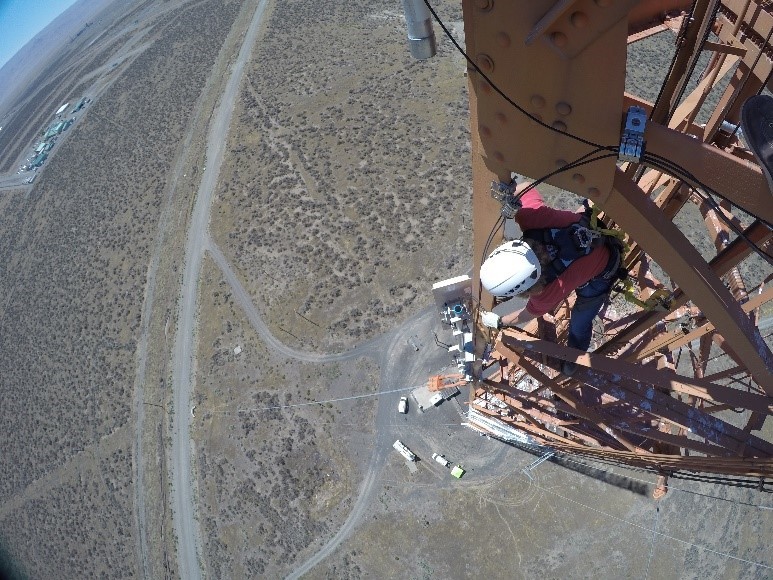 Bryan Hurt, with Mission Support Alliance’s radio maintenance organization, works on cables for critical communications systems located 365 feet up the 400-foot Hanford Meteorological Station tower.
Handwritten logs dating back to the beginning of site meteorological operations highlight weather data that helped forecast potential impacts from natural disasters and conveyed personal insights on memorable weather moments. Following the eruption of Mt. Saint Helens on May 18, 1980, a forecaster cited “heavy ash” and wrote “the birds don’t know what to do, and I don’t either” in the weather log.
Using decades of historical data and readings from today’s network of sensors, Hanford meteorologists are able to make accurate forecasts of conditions across the site.
“The weather and telephone logs are an exceptional source of information,” said Perry Perrault, Hanford meteorologist and forecaster. “You’ll find historic information on momentous wind storms, blizzards, dust storms, range fires, and thunderstorms over the decades. This data is important for climatology research and daily analysis of the weather for our Hanford Site contractors.”
Check out real-time data from the station here.
-Contributor: Melissa Ver Steeg
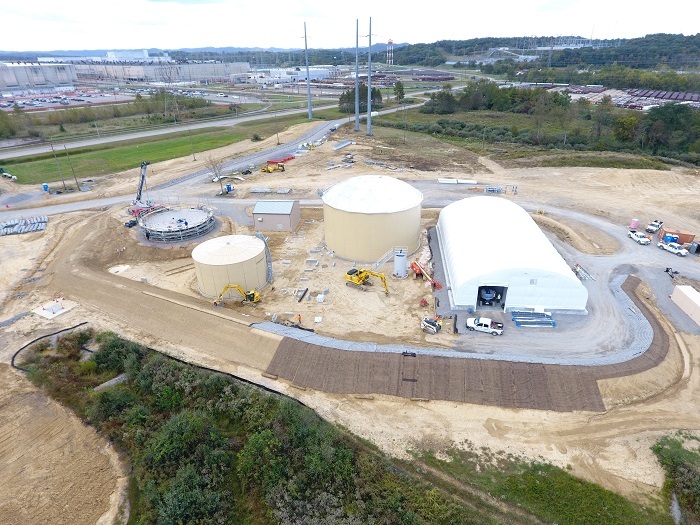 PIKE COUNTY, Ohio – EM’s Portsmouth/Paducah Project Office is installing the water treatment system for its On-Site Waste Disposal Facility at the Portsmouth Gaseous Diffusion Plant site. The disposal facility will hold much of the debris and other material from demolition of the large gaseous-diffusion process buildings and other plant facilities. Construction crews, led by EM cleanup contractor Fluor-BWXT Portsmouth, recently installed the Modular Leachate Treatment System that includes a million-gallon water tank and support structures. The tank allows for storage of additional water that might result from significant storms.
-Contributor: Donnie Locke
A drone hovers over the 3039 exhaust stack at Oak Ridge to lower a camera inside to conduct a visual inspection.
OAK RIDGE, Tenn. – What’s the safest way to climb and inspect a 70-year-old, 250-foot-tall brick exhaust stack?
That’s the question employees in Oak Ridge worked to answer, and through the use of technology and innovation, they determined no one had to climb after all.
In October, the Oak Ridge Office of Environmental Management (OREM) used a drone to conduct visual inspections inside and outside the 3039 stack. The chimney-like structure, built in 1950, is located in the central campus area of the Oak Ridge National Laboratory. Due to the age of the structure, it requires periodic inspections to evaluate its structural integrity.
The 3039 stack provides high-efficiency particulate air (HEPA)-filtered ventilation exhaust for numerous radiological facilities, including various isotope facilities in the central campus. OREM is responsible for its operation and maintenance because it is part of the Liquid and Gaseous Waste Operations infrastructure.
 A close-up view of the drone, which resembles a mini-helicopter. Following commands from a ground-based operator, the camera-mounted drone circles around the stack making recordings that can be evaluated by engineers and safety experts.
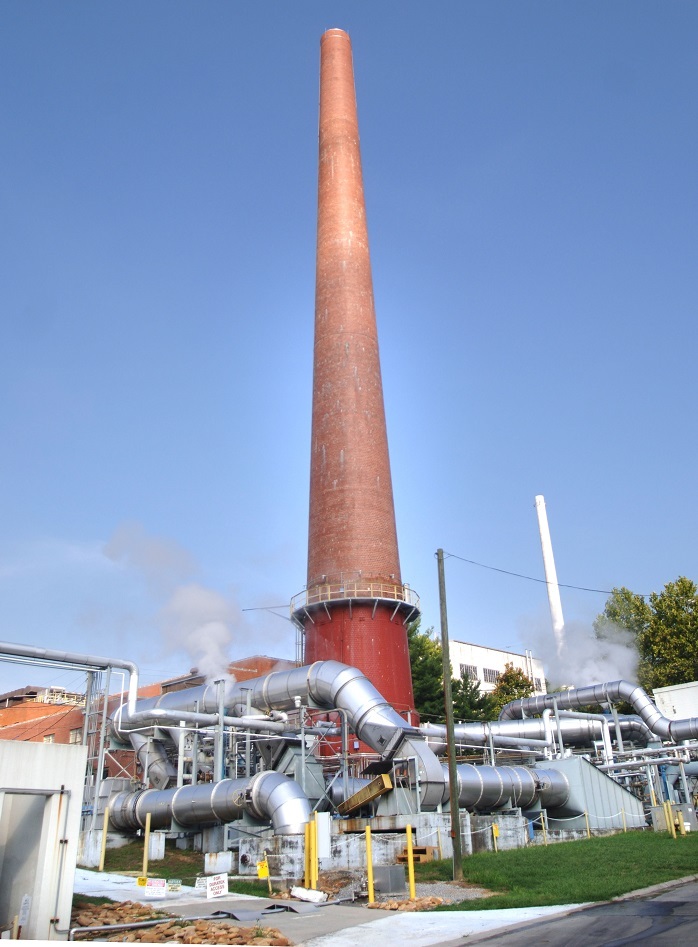 A view of the 3039 exhaust stack, which was built in 1950 and stands 250 feet tall. It provides high-efficiency particulate air (HEPA)-filtered ventilation exhaust for numerous radiological facilities, including various isotope facilities in Oak Ridge National Laboratory’s central campus.
The drone resembles a mini-helicopter. Following commands from a ground-based operator, the camera-mounted drone circles around the stack, searching for flaws that could threaten the stack’s structural integrity. The cameras record as the drone circles the stack and as it is lowered into the stack. Then, engineers and safety experts assess the footage to note any areas of concern.
The external portion of the inspection was performed using an onboard camera system, while the internal portion was performed by hovering the drone over the top opening and lowering the camera into the stack.
Previous stack inspections required inspectors to physically climb the 250-foot-tall structure. Now, technology is eliminating the need for workers to climb the stack and establish work platforms high in the air. This is the latest example of how OREM and its contractors are working together to identify approaches that will keep employees safe while performing EM’s complex and challenging cleanup mission.
-Contributor: Ben Williams
|